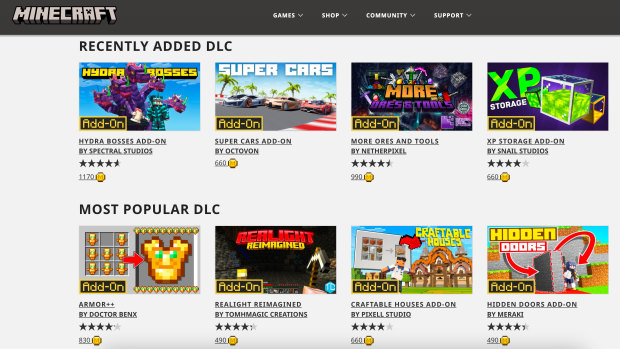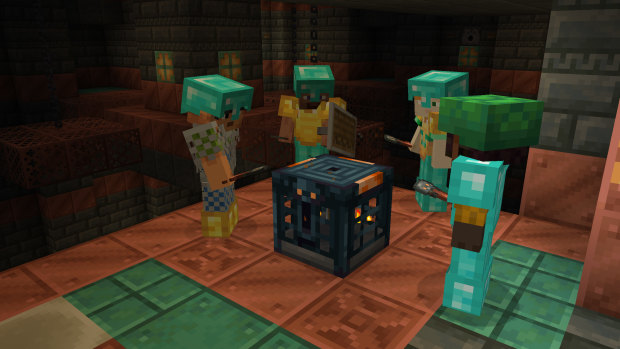“I continued working on Minecraft, and we saw it was not slowing down in any sense. One year later I was in charge of design, leading development of the game, and it just kept growing. It’s the 15th anniversary, and it’s bigger than ever.”
Key to the appeal of Minecraft is its creativity, which is different to so many other games that have discrete goals or quests.
The Minecraft world is made up of blocks of material you can mine, combine, create and build however you like, and there’s an element of persistence, in that changes you make to your world can be permanent.
The 2009 version of the game is fairly sparse, and is now free to play in browsers as Minecraft Classic.
Another key is the social element; from early on, Minecraft could be installed on servers, so multiple people could connect and play it together on the internet. From the first retail release in 2011, the game has seen constant updates and been augmented with all kinds of community modifications, which fuelled interest further.
In 2014, the game’s creator Markus Persson tweeted that he wanted to sell his rights and move on with his life. Later that year, Microsoft acquired Mojang and Minecraft for $2.5 billion ($3.7 billion). These days, the game is offered on almost every computer and console, and exists in both a modern “Bedrock” edition and a Java edition based on the original. You can still run either on your own server, or pay to rent one, but you can also just use Microsoft’s architecture for online multiplayer like any other game.
Unusually for a 2009 game, Minecraft seems to continually appeal to new generations of users. The average age of Minecraft players is 24, which is far younger than the age of game players overall. Bergensten said that part of the reason is that it never looks its age, but it also goes deeper than that.

The game can be greatly expanded using community-made mods, skins, objects and adventures, which are sold for real money and have made hundreds of millions of dollars for approved creators.
“Thanks to its simple graphics, it’s managed to become timeless. But also, for kids, the sense of exploration and adventure while being creative is mind-expanding,” he said.
“I call it emergent creativity. You’re just playing the game, but then you build something. You did it block by block, and it’s your unique creation, which makes you feel very proud. It also makes it worth talking about because it’s your story.”
The game helped popularise sandbox and survival game genres, as well as low-fi voxel (cube-look) aesthetics, which arguably led the way for games such as Fortnite and Roblox.
Elements of Minecraft, including the zombie-like Creepers and default protagonist Steve, have become cultural icons and can be seen in just about any clothing, stationary or bookshop. The game has been inducted into the Video Game Hall of Fame, had multiple spin-off games, and is set to become a movie adaptation next year, starring Jack Black.

The latest official update, Tricky Trials, adds challenging vaults for players to fight through.
Among its spun-out versions, Microsoft has long offered Minecraft Education as part of its subscription software offering for schools. It allows students to interact with each other in a virtual world and includes hundreds of free lessons across subjects including history, maths and coding. Kelly Pfeiffer, a zoo education officer based at Taronga Western Plains Zoo, said the ability to create bespoke lessons on the platform made it a valuable tool.
“Using Minecraft Education in classrooms improves student motivation and engagement, making learning more enjoyable and accessible,” she said. “It significantly boosts skills like creativity, collaboration, critical thinking, and problem-solving.”
“Our Eco Detectives game teaches them to restore biodiversity by solving problems in their virtual ecosystems. [It] not only raises awareness about species and habitats, but also promotes real-world environmental action, with supporting activities for teachers and students.”
But for all its diverse offerings, Bergensten is adamant that the base Minecraft game remains a platform for open creativity.
Loading
“Players want more Minecraft. There’s ever demand for more things to do and more things to explore and more tools and more systems. We have a lot of ideas, but we try to find ways to maintain the value of Minecraft while expanding,” he said.
“We want Minecraft to feel like Minecraft. That’s why we’re careful about making quests and such to give you a goal. Once you get into that mindset that you’re just checking off tasks, then it’s very hard to get out of it again. We want players to put their own meaning to why they’re playing.”
Get news and reviews on technology, gadgets and gaming in our Technology newsletter every Friday. Sign up here.

